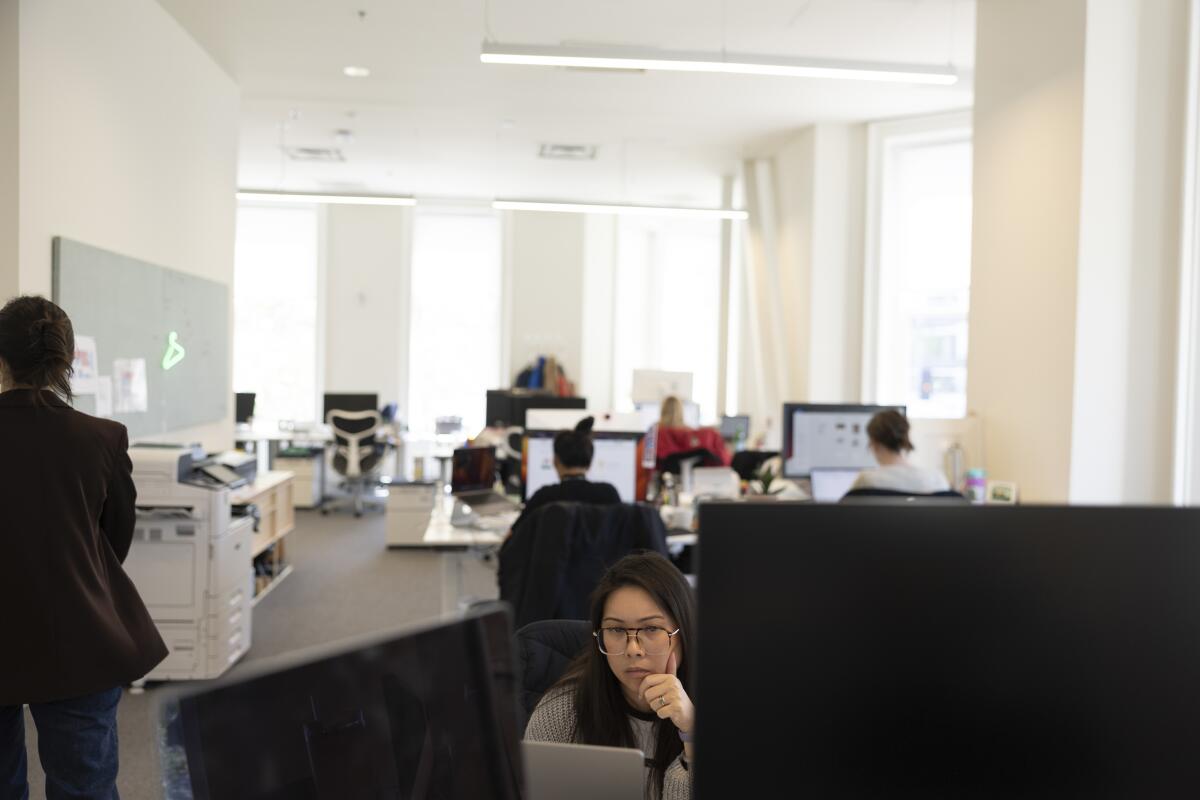How’s a four-day workweek sound? Let us know

- Share via
Good morning, and welcome to the Essential California newsletter. It’s Wednesday, May 17.
An experiment is gaining momentum in the Golden State and elsewhere in the U.S. to see how workers and the companies that employ them fare with a four-day workweek.
Times business reporter Samantha Masunaga visited two such California-based businesses to ask workers how the experiment is going for them.
One was the Oakland-based ThredUp, though the experiment is limited to its salaried corporate employees, which make up 15% of the company’s workers. So how are those workers spending their free Fridays?
“With routine tasks such as chores, doctor appointments or haircuts that they otherwise would have tried to fit into their workweek,” Masunaga wrote this week. “Some said they were able to spend more time with their children, whether that was taking them to sports events or eliminating one day’s worth of child care.”
Anton Naumenko, ThredUp’s senior director of software engineering, told Masunaga he uses Fridays to take his two kids to school, run errands and do chores to leave Saturday and Sunday open for family time.
“I don’t see myself back to five-day working weeks,” he said. “More specifically, my wife doesn’t see this.”
Stephanie Yang, ThredUp’s senior counsel for employment and litigation, shared the benefits of having more time to spend with her daughter.
“Now that I’ve experienced the freedom of both trying to maximize my impact as an employee, as well as trying to do the best for my daughter, I think it’s going to be hard for me to settle for the traditional model,” she said.
In a 2022 company survey, 93% of employees said that the four-day workweek had improved their overall productivity.
Similar experiments across the pond yielded promising results, with dozens of companies in Britain trying a four-day work week and reporting broad worker happiness — while maintaining and, in some cases, increasing revenue.
Back stateside, Masunaga was surprised to find that a majority of aerospace giant Lockheed Martin’s workforce has a four-day week.
“I found a lot of smaller companies, which made sense, but it was interesting to hear that a huge corporation like Lockheed was also doing this as a recruiting method,” she told me.
The four-day work week concept isn’t new, nor unique to the U.S. But the push to rethink the way we work hit warp speed during the pandemic, as millions of office workers swapped cubicles for couches at home and other remote sites. Now, as companies try to entice people to return to in-person work, some employers are hoping less time on the clock will lead more people to take and stay in jobs.
Researchers found people working one fewer day a week report getting more sleep through the week, which has a whole host of health benefits.
Some workers also reported a more efficient workflow, as their teams cut down on meetings and other traditional exercises deemed unnecessary (raise your hand if you’ve ever thought, “This meeting could’ve been an email”).
Working four days a week doesn’t always equate to working 32 hours. Some workers logged more hours each day of their shortened work week to keep their Fridays free. And Masunaga points to some downsides.
“Employees can get stressed out and their productivity actually decreases if company leaders don’t find ways to cut out unnecessary time sucks,” she noted.
Ali Marler, chief marketing officer at L.A.-based small business Robin Golf, said that companies should reflect on the need for five workdays versus four.
“If it’s because you actually feel like you’re not hitting your goals, then maybe there’s so much work that that’s necessary,” she said. “But if it’s just because it’s something we’re used to seeing, and you think it correlates with productivity and work output, I would strongly challenge that.”
A reduced work week might be feasible for some sectors, but there are plenty of unknowns and potential inequities to consider, including who gets excluded from these opportunities.
As Masunaga’s reporting notes, the majority of ThredUp’s workers, many working in distribution centers, still work five days a week (executives told her workers have flexible time off).
That white collar versus blue collar divide is worth exploring. And how might a four-day work week impact employees earning hourly wages?
With all the uncertainty, it’s not a mystery why a 2022 state bill that would have instituted a 32-hour work week for companies with more than 500 employees in California failed to advance in the legislature. Opponents warned of stunted job growth, increased labor costs and that it would be unsustainable for employers.
Now we’d like to hear from you, fellow working Californians.
Would you be open to a four-day work week? Or what do you feel would need to change about your workplace or industry to allow for that? And how would you spend your additional time off?
Let us know by taking this survey and you might see your and fellow readers’ responses in an upcoming edition of Essential California.
And now, here’s what’s happening across California:
Note: Some of the sites we link to may limit the number of stories you can access without subscribing.
L.A. STORIES
A “monsoon flow” is churning in Southern California skies, bringing a chance of mountain thunderstorms through Saturday. National Weather Service forecasters called the event “unusual” for this time of year. Los Angeles Times
Dancers at an L.A. topless bar are set to become the only unionized strippers in the U.S. The management of North Hollywood’s Star Garden withdrew their challenge and will recognize the union, ending a 15-month battle in which dancers demanded better, safer working conditions. Los Angeles Times

L.A. County is home to seven equestrian districts, where residents are granted leeway by the county to keep a horse despite lot size requirements. But a battle is brewing as residents in some predominantly Latino neighborhoods clash with county officials over code enforcement. Times columnist Gustavo Arellano writes: “Residents are concerned that, amid an extreme housing shortage and a mandate by Sacramento to fix that issue, county officials want to rezone the area to allow more development and destroy their equestrian way of life.” Los Angeles Times
POLITICS AND GOVERNMENT
Newly returned to Washington, Sen. Dianne Feinstein spent less than a minute speaking with reporters at the Capitol Tuesday. The exchange is something you really should read for yourself. Los Angeles Times
Gov. Gavin Newsom signed legislation this week designed to make it easier for California’s farmworkers to unionize. The new rules allow for a “card-check” system, which gives workers an opportunity to organize without the employer knowing. But the unusual deal comes with some stipulations that union leaders rescind some parts of the rules. Los Angeles Times
CRIME, COURTS AND POLICING
After three rulings from San Diego federal court Judge Roger Benitez that struck down California gun regulations, gun-safety advocates complained that multiple federal cases involving gun rights — supposedly assigned randomly — each ended up in Benitez’s courtroom. The issue stems from a local court rule that allowed “related cases” to go to the same judge’s court. A recent amendment aims to address the judicial “quirk.” San Diego Union-Tribune
Federal investigators say an Apple engineer stole company secrets and fled to China after agents visited his Mountain View home. Weibao Wang was among a select few workers with access to the tech giant’s secretive autonomous-driving project, but later secretly began working for the U.S.-based subsidiary of a Chinese company, prosecutors allege. The Mercury News
Support our journalism
HEALTH AND THE ENVIRONMENT
A new study traced a large share of forest area burned by Western wildfires to carbon emissions in an effort to link blazes with fossil fuel producers and cement manufacturers. The study’s authors say emissions generated by fossil fuel extraction and the burning of those fuels have raised temperatures, making wild spaces drier and the resulting fires more destructive. Los Angeles Times
CALIFORNIA CULTURE
Good news, breakfast lovers: Californians are shelling out fewer dollars for eggs in recent weeks. Prices had soared in the past year after a bird flu outbreak, with a dozen large eggs reaching $7.37 in January. The current average price is $1.68 — and I see more omelets in my future. Los Angeles Times
Free online games
Get our free daily crossword puzzle, sudoku, word search and arcade games in our new game center at latimes.com/games.
AND FINALLY
Today’s California landmark is from John Vincent of Portland, Ore.: Potato Harbor on Santa Cruz Island.

John writes:
This affirms what Reagan [reportedly] said: “Had the Pilgrims landed in California the East Coast would be wilderness.”
What are California’s essential landmarks? Fill out this form to send us your photos of a special spot in California — natural or human-made. Tell us why it’s interesting and what makes it a symbol of life in the Golden State. Please be sure to include only photos taken directly by you. Your submission could be featured in a future edition of the newsletter.
Please let us know what we can do to make this newsletter more useful to you. Send comments to essentialcalifornia@latimes.com.
Sign up for Essential California
The most important California stories and recommendations in your inbox every morning.
You may occasionally receive promotional content from the Los Angeles Times.







